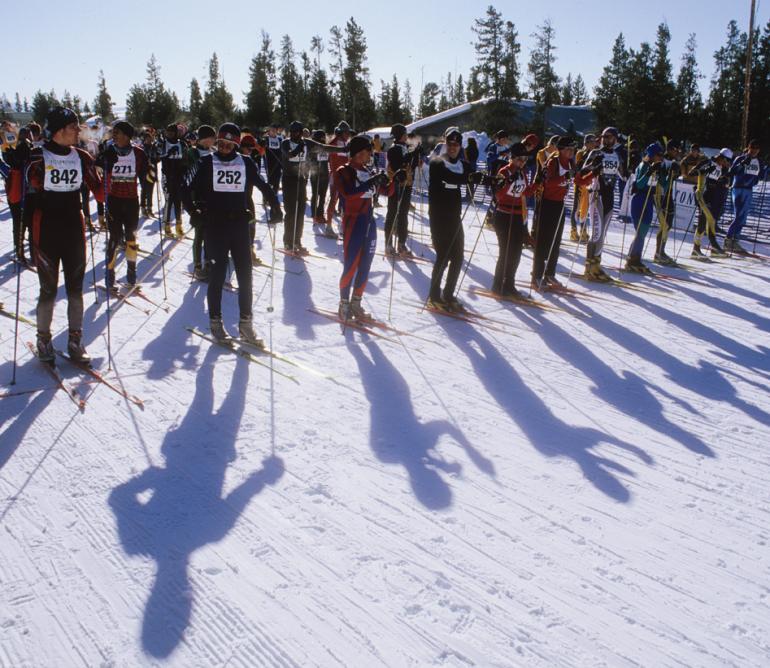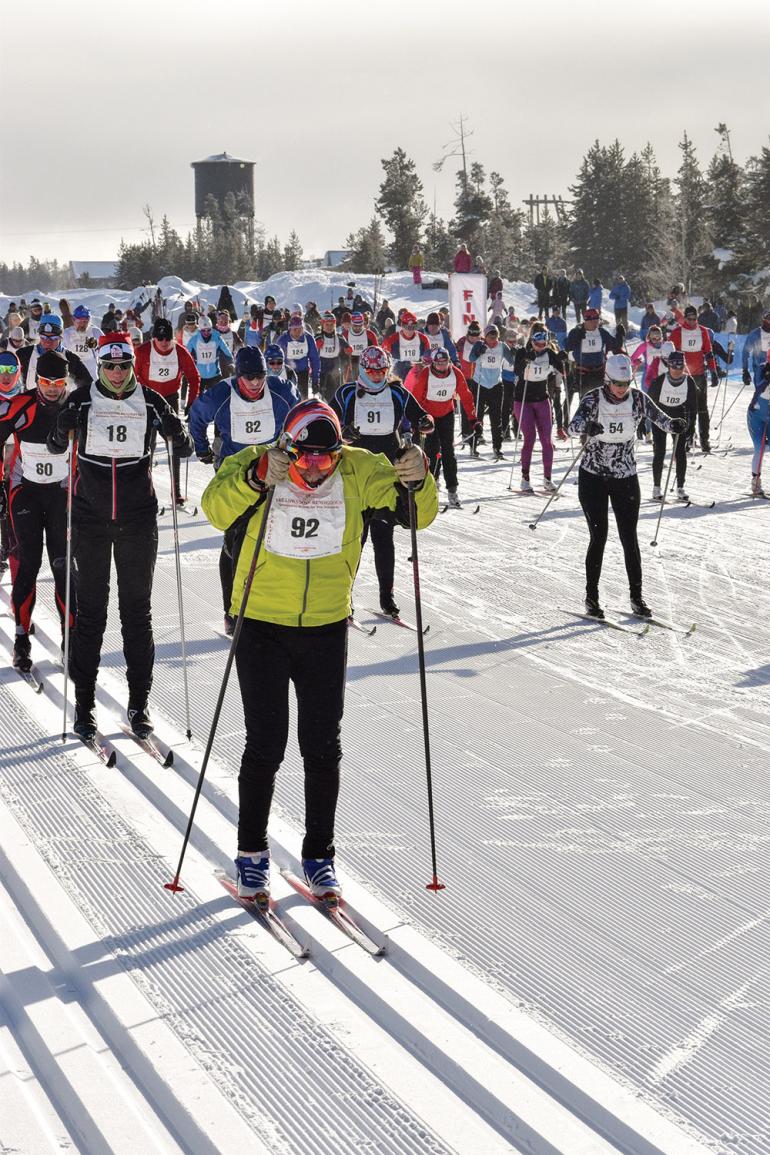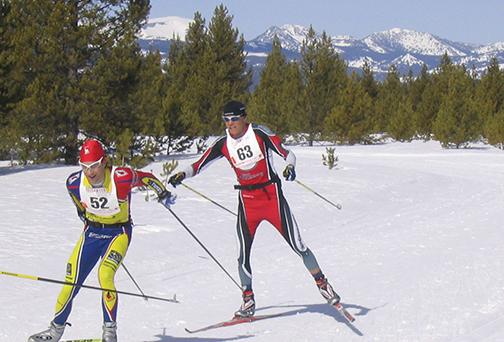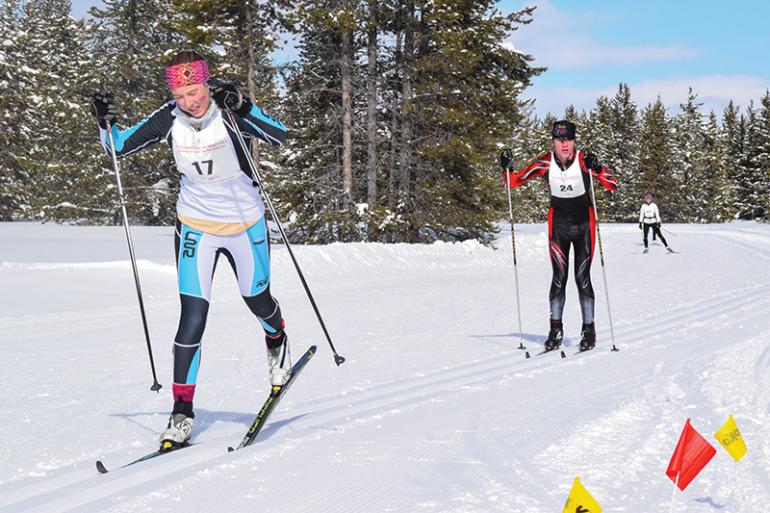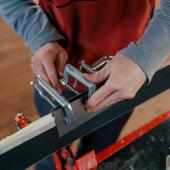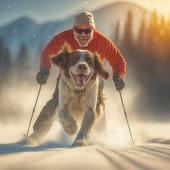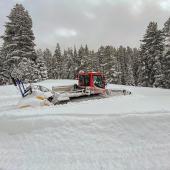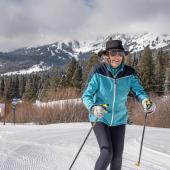Yellowstone Rendezvous
Best skiing of the year.
A big Nordic party for hearty outdoorsy types, the Yellowstone Rendezvous, held each March in West Yellowstone, lures over six hundred competitors from all over the world. Racers often stay a night or two, visiting with friends and children, listening in at prerace meals and hot tubs for the secret wax concoction the top guys are smearing underneath their skis.
The Top Guys are the Olympic hopeful men and women who attend early training camps in West Yellowstone in November, then return for Rendezvous in March. In addition to several children’s races, Rendezvous events include a classic 25-kilometer race and skating races of 10, 25, and 50 kilometers, which is called the ski marathon—the equivalent of running a standard 26 mile marathon plus change. My goal was to complete the 25K skate race; lofty enough for me.
When snow came in November 2000, I began sneaking out during lunch breaks—as much as one sneaks wearing Day-Glo bargain skate boots from the ski swap—for a ski on the groomed trails at Lindley Park. “Nice boots,” the office manager would say.
Weekends I’d go to Bohart Cross Country Ski Ranch up Bridger Canyon, first surviving the uphill climb around Logger’s Loop, then progressively adding other loops to that, always trying to do the math to see if I was anywhere near 25K. I kept a training log, ate overpriced energy bars made of compressed sawdust and raisins, attended technique clinics, verified my new jiggle-free triceps in the mirror and began subscribing to The Master Skier. I skated in my sleep; dreaming my V2 resembled a speedy waltz across white corduroy.
In reality, it is not in my genetics to be fast. My people don’t even read or write quickly; never mind blasting uphill past people with names like Lars or Ingrid. Hence, my primary goal was to finish the race, but the secret goal is to creep up to first place in my age group. I figure all I have to do is outlive some people and keep skiing.
There’s no better sport than cross-country skiing for total fitness. The gravity of this hit me when I arrived in West Yellowstone the night before the race. No mistaking this for a french fry convention; the town seemed surreally seized by genetically modified people, sculpted of lean muscle fiber. I looked for somebody with a little chub who might race me. Where was the Fun Run crowd you see at every running race? Maybe I was the lone Fun Runner.

I took this realization back to my hotel room and went through my race packet: racing number, long-sleeved t-shirt, course map, lengthy disclaimer stating that it’s not their fault if the race kills me, granola bars, a wax scraper from Swix...I ran my hands along the bottom of my skate skis once again and stared out at falling snow. I had sprung for a high-end race prep at Bangtail Bike & Ski back in Bozeman, grilling Stan, who works back in the ski shop. “How are you guys gonna know which wax to put on my skis? Have you checked the forecast? I hear it’s supposed to snow.”
Stan was unfazed, explaining to me that they wait until the last possible moment on Friday to begin waxing skis for Saturday’s race, cross-referencing several final hour weather and wax reports by phone and internet. Waxing is taken seriously, as the wrong wax—especially for a classic skier—can severely compromise performance. For those in the elite pack, the most precise wax can win the race.
Feeling too somber for the Jacuzzi, I tried to read. After a half an hour, I decided what could really help my race was a good night’s sleep. The only problem was, I wasn’t tired. My body was charged up and ready to race, my thoughts bumping around like
flitting bats. I tried more reading, then turned out the light, hoping that would make me drowsy. Two hours passed, I tried meditating, counting, a glass of wine, more reading, a hot bath. I tried convincing myself that I didn’t care if I slept or not, but I didn’t buy it.
At three a.m. I called the front desk, desperate, inquiring if there might be even a gas station open that would have something to help me sleep. No luck.
I began questioning all the time and energy I had invested in coming here. Even if I won the race, would I win respect, become a happier person? What if I came in last? Somebody always does.
At seven a.m. I pulled back the heavy curtain, revealing a blanketed world, sparklingly illuminated by a blinding blast of sun on my sleepless eyes. Perfect conditions. I envisioned packing my things, driving through the Gallatin Canyon back to Bozeman, no race.
I heard people laughing, clomping down the hall to claim their free juice and cereal in the lobby. Maybe I could do it, a fun run effort. Coming in last might feel better than the sure defeat of not skiing at all.
After breakfast, I guzzled a can of Whoop Ass before heading to the race, pleased with my new resolve. The starting area was chaotic, racers milling around like worker ants, the elite racers easy to pick out in their bright Lycra suits. I got in the long line to the Porta Potty, wishing I was as well equipped as one Spandex Guy who left the line and aimed at a nearby snowbank, shoulders hunched for privacy.
The beginning of the 25K skate race was a stampede, as nearly two hundred skiers aggressively funneled forward on the groomed track, about the width of a single-lane road. Click, clack. Clack! “Oh ouch, sorry. Sorry.” Someone mooed. Everyone floundered and bumped into each other’s skis, trying not to jab anyone with poles, grateful when the first few minutes passed and everyone spread out.
After three kilometers I could no longer gauge where I was in the pack, so I glided along, surprised that I was feeling pretty good, like I could push harder. A lady with wrinkles and a hacking chest cough passed me. I dismissed that frantic Being Passed feeling, reminding myself of the twenty-two remaining kilometers.
At eight kilometers I was picking off a long, narrow hill when I heard huffing behind me, sensed the gorilla shoulders of a large man. “To your left!” he commanded, the standard way of asking someone to move aside. I moved to the right, still skiing, but
nearly stalling out behind a slower skier in front. I waited for the commander to pass, but he was still hyperventilating behind me, so I passed the person in front, the breather following.
“To your left!” he said again, and I slid right as the scene repeated itself. “Aw, damn. Forget it,” he finally said, and I laughed with this stranger whose face I never saw.
Fifteen kilometers in I skated passed a group of people wearing a combination of Hawaiian and Arctic attire handing out water, Gatorade and cookies. “Vote for us!” one of them yelled, hoping for the prize for best feed station. I noticed broken poles strewn along the side of the track like discarded bones, incredulous that a pole could break and wondering what those racers did in such a situation. I later discovered that those were the new ultralight carbon racing poles and gave silent thanks for my heavy old clunkers; permission not to upgrade.
After nineteen kilometers my excitement at nearly finishing helped postpone acknowledgement of the pain in my tightly stitched lower back. I tried to soothe myself with the passing scenery of pristinely undeveloped, snow-draped evergreens upon rolling white hills; how I imagine a Scandinavian forest.
The last stretch was flat as a sheet cake and I tried to conjure that speedy V2 waltz. Crowds of people appeared along the sidelines for the last two kilometers, hollering encouragement through the cold sun as I forced an imitation of a final sprint. I went for it, huffing hard, heard the announcer call out my number and that I was from Bozeman, a few cheers.
I checked the clock as I crossed the finish line: one hour and twenty-one minutes. I looked around, seeing plenty of older and younger racers who had finished before me, watched plenty straggle in after as I took off my skis and propped them against a snow bank. My backache was official. I guzzled water as if I’d been lost in a desert and cheered for the last finishers until the rumble of voices over lunch tugged me away.
I traded the lunch ticket stapled to my racing bib for a steamy bowl of chicken noodle soup, yogurt, and a cookie. “Hey there, how’d it go?” people called. “Which race did you do?”
And the Rendezvous camaraderie, corny as it sounds, was palpable; I felt so good I swear I could’ve worn Lycra.
Megan Ault has written for many local and national magazines inlcuding Parents, Runner's World, and Shape. For more info about the Yellowstone Rendezvous, visit rendezvousskitrails.com.

